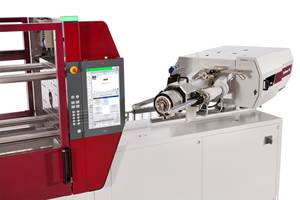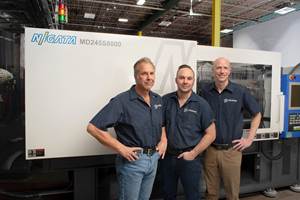Automotive Insert Molders Try Microcellular Route to Precision Parts
Insert molders and assembly suppliers serving North America’s automotive industry have found a new range of benefits from the MuCell microcellular foaming process licensed by Trexel Corp.
Insert molders and assembly suppliers serving North America’s automotive industry have found a new range of benefits from the MuCell microcellular foaming process licensed by Trexel Corp. In that process, CO2 or nitrogen in supercritical form is injected into the melt, creating micro-bubbles that reduce melt viscosity and part density. Benefits most commonly cited versus injection molding solid parts are reduced materials use, lower weight, and abbreviated cycle times.
In insert molding, however, the key advantage of microcellular foaming is turning out to be improved precision and dimensional stability in intricate devices like sensors and meters. The payoffs are showing up in reduced reject rates, accelerated assembly times, and better-quality parts.
“Material savings and cycle-time reductions are welcome but are not the primary reason for microcellular foam processing of sensitive parts in most cases,” states Jeff Terrell, product-development manager at Tricon Industries in Lisle, Ill. A recent Tricon success with MuCell foaming is an insert-molded air-blower base that directs and controls heat and air to the rear of Chrysler mini-vans. The processor, a specialist in metal insert molding, was one of several attendees at the recent SAE (Society of Automotive Engineers) Show in Detroit that expressed this new view of microcellular foaming.
Another is Delphi Automotive Systems in Flint, Mich, which made a presentation on its new mass air-flow meter, which exploits microcellular foam in a similar manner. “The process significantly reduces warpage due to uneven shrinking of parts, and improves consistency and assembly ease,” said James Katterman, a Delphi senior project engineer.
In insert molding, warpage is especially challenging, industry sources say, since dimensional stability is influenced by differential shrinkage of the metal insert and overmolded plastic and also by the position the metal insert has in a part design. Cost of the metal insert, moreover, is usually substantially higher than the plastic used, so that resin savings from foaming are a relatively minor consideration.
More predictable results
Delphi’s new air meter is a two-component device made of 30% glass-and mineral-reinforced PBT supplied by Ticona. The part includes a metal sensor that must be accurately positioned in an overmolded PBT carrier. In addition, tubes to direct the flow of air precisely to the meter are mated to the carrier via an intricate molded-in slide-and-latch system. The precision of these parts is critical, since the air meter adjusts the ratio of air and fuel in the vehicle to optimize mileage per gallon and minimize emissions.
“It would have been difficult to get the necessary dimensional stability and part consistency to accurately measure air flow without using microcellular foaming,” says Katterman. In assembling the entire system, he says, improved consistency and dimensional stability of the various parts translates into more efficient assembly methods, paving the way for significant cost savings.
A specific challenge was the broad thermal cycling (from -40 to +200 F) to which the carrier is subjected. In solid molded versions, thermal cycling led to cracking of the O-ring used to position the part, whereas the foamed product proved crack resistant. As for the flow tubes, microcellular foaming helped refine their accuracy by making them more concentric. Delphi reports that solid air tubes had typically been off-center by 2° to 3°, as compared with around 0.5° variance for microcellular foam versions. Because the part dimensions were more predictable, Delphi’s molder was able to fine-tune the production tool faster and at lower cost.
More traditional benefits were also harvested by Delphi, but only to the extent possible without harming precision and performance. Density reduction was kept to a modest 10% or less. In thick-section parts like this one, microcellular foaming typically tends to extend the cooling time, so the final outcome was no overall cycle-time reduction.
In Tricon’s case, improved flatness afforded by microcellular foaming was critical in converting the air-blower base to Trexel’s process. The 8-in. part embeds a metal connector in an overmolding of mineral/glass-filled nylon 6/66 blend supplied by Wellman, Inc. of Johnsonville, S.C. In a solid-molded version, flatness variance along the part’s length was 0.06 in. In the MuCell-foamed version, however, flatness variance is reduced seven-fold to 0.008 in. In addition, Tricon gained about 10% materials savings, while cycle time was cut by 15%. A significant reduction in clamp tonnage allowed Tricon to run the part on a smaller injection machine.
Gentler to electronics
Looking ahead, Tricon’s Terrell says his firm anticipates increased use of microcellular foaming for parts that involve encapsulating semiconductors and other sensitive devices. He says a largely untapped benefit of Trexel’s process is a drop of around 100° F in melt temperature during molding. That, combined with reduced melt viscosity, is said to open the way for molders to minimize the overall thermal and mechanical shock to delicate electrical components during encapsulation.
Daniel Szczurko, Trexel’s v.p. of marketing, adds that better understanding of the way microcellular foaming affects the mechanical properties of parts is also helping molders to take advantage of the process in more subtle ways. Research by Ticona shows the reduction in properties in 30% glass-reinforced PBT is very slight for low levels of foaming. A 10% density reduction leads to at most 4% declines in stiffness and toughness. Ticona says the pattern is similar for PPS and other resins. Since a margin of safety is built into many automotive applications, this body of information is allowing insert molders to get moderate density reductions while minimizing adverse effects on part performance.
Related Content
Fakuma 2023: More Details on New Machine Line
Wittmann Battenfeld has released more details on the new EcoPower B8X debuting at Fakuma (October 17-21; Friedrichshafen, Germany), which it previously announced.
Read MoreFakuma 2023: Wittmann Battenfeld Expands All-Electric Line, Direct-Current Capabilities
Wittmann Battenfeld will introduce the new EcoPower B8X injection molding machine line and show direct current as an energy source for a concept machine that will power its own robot.
Read MoreCustom Injection Molder Plugs into All Electric Machines
Formerly a showroom for early-aughts-era Van Dorn hydraulics, the newest additions to Drummond Industries’ transforming fleet are all-electric Niigata injection molding machines.
Read MoreInjection Compression Molding as Alternative to Thermoforming
Arburg will show its all-electric Allrounder 720 A press utilizing injection compression molding to create thin-wall IML cups from PP.
Read MoreRead Next
People 4.0 – How to Get Buy-In from Your Staff for Industry 4.0 Systems
Implementing a production monitoring system as the foundation of a ‘smart factory’ is about integrating people with new technology as much as it is about integrating machines and computers. Here are tips from a company that has gone through the process.
Read MoreProcessor Turns to AI to Help Keep Machines Humming
At captive processor McConkey, a new generation of artificial intelligence models, highlighted by ChatGPT, is helping it wade through the shortage of skilled labor and keep its production lines churning out good parts.
Read MoreWhy (and What) You Need to Dry
Other than polyolefins, almost every other polymer exhibits some level of polarity and therefore can absorb a certain amount of moisture from the atmosphere. Here’s a look at some of these materials, and what needs to be done to dry them.
Read More

















.png;maxWidth=300;quality=90)









